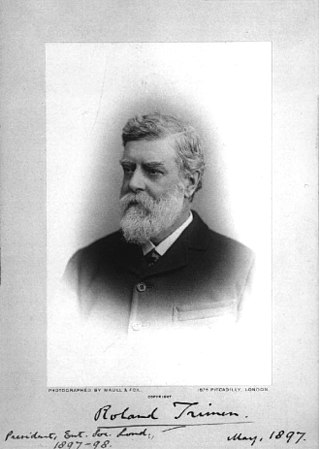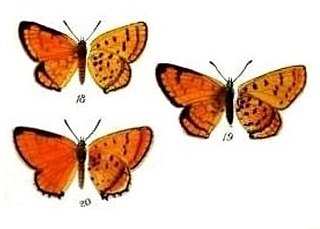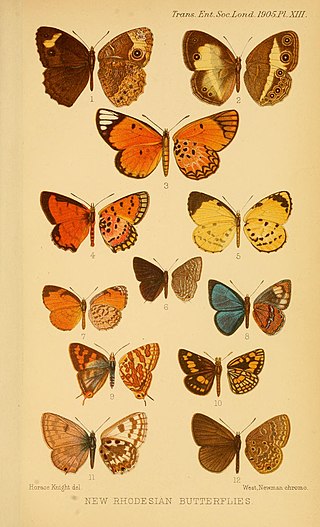
The superfamily Papilionoidea contains all the butterflies except for the moth-like Hedyloidea.

Lycaenidae is the second-largest family of butterflies, with over 6,000 species worldwide, whose members are also called gossamer-winged butterflies. They constitute about 30% of the known butterfly species.

Riodinidae is the family of metalmark butterflies. The common name "metalmarks" refers to the small, metallic-looking spots commonly found on their wings. The 1,532 species are placed in 146 genera. Although mostly Neotropical in distribution, the family is also represented both in the Nearctic, Palearctic, Australasian (Dicallaneura), Afrotropic, and Indomalayan realms.

Roland Trimen FRS was a British-South African naturalist, best known for South African Butterflies (1887–89), a collaborative work with Colonel James Henry Bowker. He was among the first entomologists to investigate mimicry and polymorphism in butterflies and their restriction to females. He also collaborated with Charles Darwin to study the pollination of Disa orchids.

The short-tailed blue or tailed Cupid is a butterfly that forms part of the family Lycaenidae. It is found from Europe to Japan and in India.

William Chapman Hewitson was a British naturalist. A wealthy collector, Hewitson was particularly devoted to Coleoptera (beetles) and Lepidoptera and, also, to birds' nests and eggs. His collection of butterflies, collected by him as well as purchased from travellers throughout the world, was one of the largest and most important of his time. He contributed to and published many works on entomology and ornithology and was an accomplished scientific illustrator.

The Aphnaeinae are a subfamily of butterflies in the family Lycaenidae.

Erikssonia acraeina, the Eriksson's copper, is a species of butterfly in the family Lycaenidae. It was long thought to be monotypic within the genus Erikssonia. It is found in the southern parts of the Democratic Republic of the Congo, southern and south-eastern Angola, and western and north-western Zambia.
Erikssonia is a genus of fungi in the family Phyllachoraceae.
Euthecta is a genus of butterflies in the family Lycaenidae. The two members (species) of this genus are endemic to the Afrotropical realm.

Erikssonia is a genus of butterflies in the family Lycaenidae. They are found on sandy substrates, though E. edgei appears to be found on more loamy sand than its congeners. They are slow fliers.

Erikssonia edgei, commonly known as the Waterberg copper, tilodi copper or Edge's acraea copper, is an obligate myrmecophylous lycaenid butterfly, which is native to Limpopo, South Africa. The critically endangered butterfly occurs in high-altitude grasslands on sandy substrates, and has only been obtained from the type and one subsequent locality. The population at the type locality, a farm in the Waterberg, went extinct about 12 years after its 1980 discovery. It was afforded species status in 2010, when no extant populations were known. The status of two populations, discovered in 2013 at a private nature reserve to the southeast, remains indeterminate.

Azygophleps is a genus of moths belonging to the family Cossidae.
Azygophleps cooksoni is a moth in the family Cossidae. It is found in Natal Province, South Africa.

Bicyclus cooksoni is a butterfly in the family Nymphalidae first described by Hamilton Herbert Druce in 1905. It is found in northern Zambia, the Democratic Republic of the Congo, southern and western Tanzania and Zimbabwe. The habitat consists of Brachystegia woodland and open montane grassland-forest mosaic.
Euphaedra cooksoni is a butterfly in the family Nymphalidae first described by Herbert Druce in 1905. It is found in the Democratic Republic of the Congo, Tanzania and Zambia.
Euthecta cooksoni, the Cookson's buff, is a butterfly in the family Lycaenidae. It is found in Tanzania and Mozambique.

Willema angolana is a species of butterfly in the family Hesperiidae. It is found in Angola, the Democratic Republic of the Congo (Shaba) and Zambia.
Geodia cooksoni is a sponge species in the family Geodiidae. The species was first described by British scientist William Johnson Sollas in 1888 under the name Cydonium cooksoni. It is found in the waters of the Pacific Ocean around the Galápagos Islands.
This page is based on this
Wikipedia article Text is available under the
CC BY-SA 4.0 license; additional terms may apply.
Images, videos and audio are available under their respective licenses.












